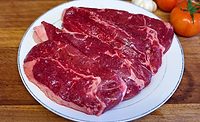Study: Safer meat requires reducing risks where food animals are raised
A variety of pre-harvest interventions can significantly reduce the risk that bacteria harmful to humans will infect food animals.

Wider use of evidence-based food safety interventions on farms and feedlots would significantly reduce the risk of people getting sick from contaminated meat and poultry, according to a report released The Pew Charitable Trusts, Philadelphia.
The report, “Food Safety From Farm to Fork,” examines potential means to prevent foodborne illnesses by investing in strategies to control Salmonella, E. coli and other pathogens that live in and around food animals. Cattle, poultry and swine often harbor these microorganisms before they reach the slaughterhouse gate, where the U.S. Department of Agriculture’s oversight authority starts.
A variety of pre-harvest interventions—from ensuring that water and feed are clean to administering vaccines and other preventive treatments—can significantly reduce the risk that bacteria harmful to humans will infect food animals.
“An effective food safety system includes measures to prevent contamination at every step along the meat and poultry supply chain,” says Sandra Eskin, director of Pew’s safe food project. “More can and should be done on farms and feedlots.”
The report identifies successful pre-harvest interventions, including several already used by some producers in the United States and other countries, and highlights those that have been shown to reduce the risk of illness associated with contaminated meat and poultry. To develop and increase adoption of effective pathogen control strategies, the report makes the following recommendations:
- Government agencies should fund research into how to best manage herds or flocks to maintain animal health and keep harmful bacteria out, support field trials to gather accurate data on efficacy, application protocols and the basic science associated with promising but poorly understood pre-harvest interventions, designate resources to evaluate how to best combine multiple existing interventions and consider incentives to spur additional research into pre-harvest food safety efforts.
- Regulatory agencies should provide incentives for the implementation of pre-harvest food safety interventions, including those that enhance biosecurity and herd and flock management practices; consider ways to systematically synthesize data and prioritize where and when interventions should be applied; improve the regulatory approval process to ensure that promising products reach the market; and increase collaboration and communication among all stakeholders to raise awareness about promising interventions.
- Industry should consider individual pre-harvest interventions within the larger context of managing the health of the herd or flock and implement adequate controls to protect animal health and keep pathogens out, such as setting standards for the safety of feed and water on farms and feedlots.
- All stakeholders should develop information technology infrastructure and capacity to encourage sharing of efficacy and safety data among industry, academia, governmental researchers and regulatory agencies, and keep all parties apprised of up-to-date research and information.
“Collaboration among producers, researchers and regulators is critical to ensure food safety hazards are minimized before the animals ever reach slaughter,” says Karin Hoelzer, a veterinarian with Pew’s safe food project. “The adoption of evidence-based interventions outlined in this report will mean fewer people will be sickened by contaminated meat and poultry products.”
This article was originally posted on www.refrigeratedfrozenfood.com/.
Looking for a reprint of this article?
From high-res PDFs to custom plaques, order your copy today!





